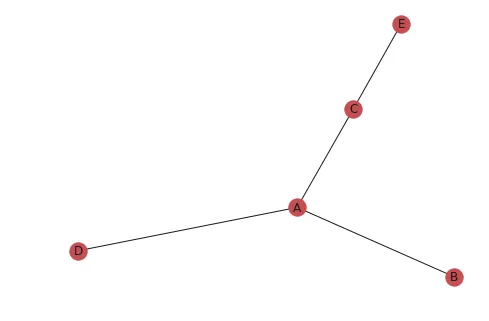Drawing NetworkX Network Graphs in python3
NetworkX is a Python library for studying graphs and networks. NetworkX is free software released under the BSD-new license. It can be used to create and manipulate complex networks, and to study the structure and function of complex networks.
With NetworkX, you can load or store networks in standard or non-standard data formats. It can generate many types of random or classic networks, analyze network structure, build network models, design new network algorithms, and draw networks.
Of course, NetworkX alone cannot be powerful. Here, Chunjian Muke will use other widely used common Python libraries to draw various basic network graphs.
1. Drawing the Most Basic Network Graph
A network graph consists of nodes and edges. In NetworkX, each row of a pandas DataFrame represents the points in a connection, and a connection is generated at the corresponding position. In the example, a connection is generated between each corresponding position of ‘from’ and ’to’.
################import required libraries
import pandas as pd
import numpy as np
import networkx as nx
import matplotlib.pyplot as plt
################Draw network graph
df = pd.DataFrame({ 'from':['A', 'B', 'C','A'], 'to':['D', 'A', 'E','C']})
basic_net=nx.from_pandas_edgelist(df, 'from', 'to')
fig = plt.figure()
nx.draw(basic_net, with_labels=True)
plt.show()

Drawing a network graph using NetworkX only requires the simple steps above.
1. Importing Data
basic_net=nx.from_pandas_edgelist(df, 'from', 'to'). Of course, NetworkX supports importing various data formats. For details on nx.from_pandas_adjacency, please refer to https://networkx.github.io/documentation/latest/reference/convert.html
2. Drawing the Graph
nx.draw(basic_net, with_labels=True)
3. Display
plt.show()
2. Differentiating Connection Colors and Sizes Between Nodes
Since the importance of connections between different nodes varies, using line segments or colors of different sizes for connections becomes extremely important. NetworkX conveniently provides this function; you just need to specify edge_color during the drawing process.
################import required libraries
import pandas as pd
import numpy as np
import networkx as nx
import matplotlib.pyplot as plt
df = pd.DataFrame({ 'from':['A', 'B', 'C','A'], 'to':['D', 'A', 'E','C'], 'value':[1, 10, 5, 5]})
################Draw network graph
color_net=nx.from_pandas_edgelist(df, 'from', 'to', create_using=nx.Graph() )
###Specify color and size
fig = plt.figure()
nx.draw(color_net, with_labels=True, node_color='skyblue', node_size=1500, edge_color=df['value'], width=10.0)
plt.show()

3. Setting Network Graph Background Color
In NetworkX, you can set the background color simply by using set_facecolor.
################import required libraries
import pandas as pd
import numpy as np
import networkx as nx
import matplotlib.pyplot as plt
df = pd.DataFrame({ 'from':['A', 'B', 'C','A'], 'to':['D', 'A', 'E','C'], 'value':[1, 10, 5, 5]})
################Draw network graph
color_net=nx.from_pandas_edgelist(df, 'from', 'to', create_using=nx.Graph() )
###Specify color and size
fig = plt.figure()
nx.draw(color_net, with_labels=True, node_color='skyblue', node_size=1500, edge_color=df['value'], width=10.0)
fig.set_facecolor("#AAAA00")###Add only here
plt.show()

Summary
This article provides a basic introduction to using the NetworkX package for drawing network graphs. If you’re wondering how to draw network graphs in Python, NetworkX is the way to go. For detailed official documentation, please refer to NetworkX Official Documentation.
- 原文作者:春江暮客
- 原文链接:https://www.bobobk.com/en/229.html
- 版权声明:本作品采用知识共享署名-非商业性使用-禁止演绎 4.0 国际许可协议进行许可,非商业转载请注明出处(作者,原文链接),商业转载请联系作者获得授权。